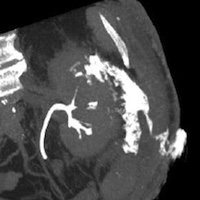Gelatin sponge (Spongostan®) and N-butyl-2-cyanoacrylate: Utility on percutaneous treatment of persistent urinary leakage after partial nephrectomy. Case report and review of the literature

All claims expressed in this article are solely those of the authors and do not necessarily represent those of their affiliated organizations, or those of the publisher, the editors and the reviewers. Any product that may be evaluated in this article or claim that may be made by its manufacturer is not guaranteed or endorsed by the publisher.
Introduction: Percutaneous treatment of persistent urinary fistula after partial nephrectomy using N-butyl-2-cyanoacrylate and gelatin sponge (Spongostan®) is an effective and relatively non-invasive procedure that should be considered when a conservative approach fails. Three successful cases of percutaneous embolization by using N-butyl-2-cyanoacrylate have been reported in the literature. To our knowledge, the use of Spongostan for the treatment of urinary fistula after partial nephrectomy has not been previously described.
Case report: We present the case of an 82-year old man who underwent percutaneous closure of a urinary fistula following partial nephrectomy by using gelatin sponge (Spongostan®) and N-butyl-2-cyanoacrylate.
Conclusions: We encourage the use of this technique in selected cases. Collaboration amongst urologists and skilled interventional radiologist is strongly recommended.
PAGEPress has chosen to apply the Creative Commons Attribution NonCommercial 4.0 International License (CC BY-NC 4.0) to all manuscripts to be published.


 https://doi.org/10.4081/aiua.2020.3.200
https://doi.org/10.4081/aiua.2020.3.200



